Papers by dawid soszyński
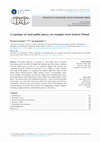
Bulletin of Geography. Socio-economic Series
The paper proposes a typology of rural public places, actually functioning in the social life of ... more The paper proposes a typology of rural public places, actually functioning in the social life of villages, pointing out the distinctness of this system from the public space of cities or even suburban villages. The research was conducted using the method of interviews in 21 villages located in eastern Poland. A total of 124 interviews were conducted thanks to which 169 public places were identified and characterized. The result of analyses is a typology that includes 8 basic types of rural public places: Multifunctional village squares; Grocery surroundings; Other service facilities surroundings; Sacred sites; Village streets; Neighborhood space; Recreational places; Semi-natural places. Most of them are unintentionally created places. The research shows that multifunctional places - both central and typically recreational - are crucial for rural areas, while semi-natural places are the most characteristic. However, we did not find any basis for distinguishing a separate category i...

Context. The paper concerns on measuring the values of urban informal green spaces. In times of n... more Context. The paper concerns on measuring the values of urban informal green spaces. In times of new challenges importance of informal greenery for landscape ecology and quality of life in the cities increases. Objectives. The objectives of the study is to develop the criteria for expert assesment of visual attractiveness of informal green spaces and compare the results of expert assesment with indicators derived from spectral indexes and GIS data. Methods. The study area is Lublin in Poland, a medium-sized European city. Expert assessment includes: general assessment - defining overall attractiveness, naturalness, landscape contrast and uniqueness. We juxtaposed the results with spectral indexes: LST, NDVI, LAI and GIS data. The analyses were performed for the target areas and a 300 m buffer zones around them. Results. The spectral indexes largely confirm the results of the expert assessment. Clear relationship exists between overall attractiveness and temperature and between landsc...
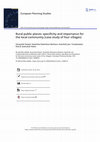
European Planning Studies, 2021
The paper presents the outcome of research into the unique character of public places in rural ar... more The paper presents the outcome of research into the unique character of public places in rural areas and the importance of different types of places for the local community. A complex methodology was used, including expert research, interviews and surveys, on the basis of which seven qualities defining the vitality of a place and three features defining the meaning of a place were assessed. Research was conducted in four villages representative of eastern Poland. The obtained results prove that each village, regardless of its size, rank, function and development, has public places important for residents. The distinguishing features of rural public places are spontaneity, informality and a close involvement of residents in their formation. The most essential are still multifunctional village squares (boasting high vitality) with shops fulfilling the key role of the main centres of social activity in the country. However, everyday and central places are losing their prominent position in favour of recreational spaces (with high vitality and meaning). Semi-natural places (high meaning), characteristic of rural areas, have proved to be very important because they often combine private ownership with freedom of access and bottom-up forms of development.
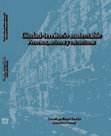
En los ultimos anos, los estudios urbanos especializados insisten en que los procesos de urbaniza... more En los ultimos anos, los estudios urbanos especializados insisten en que los procesos de urbanizacion por los que atraviesan los distintos paises desarrollados, parecen dejar atras las explicaciones de la urbanizacion industrial, han surgido otras construcciones y perspectivas unas mas acabadas que otras (Indovina, 1998, la “ciudad difusa”; Dematteis 1998, ciudad sin centros; Nel-lo, 1998 ciudad sin confines, Soja, 2008, la exopolis). En suma se dice que se avanza hacia la urbanizacion generalizada, ello acaba con la larga trayectoria del funcionamiento y naturaleza de la ciudad moderna, el cambio urbano estructural actual, es nuevamente, consecuencia de la descentralizacion, difusion, redistribucion del desarrollo, del crecimiento y las innovaciones ahora sobre una estructura en el territorio. Ha sido una mutacion no solo empirica sino que ha dado lugar a la confrontacion teorica. El sistema urbano jerarquico ha reducido su valor interpretativo porque se han modificado los supuesto...
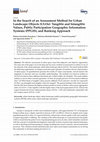
Land, 2020
The effective assessment of urban space must link subjective and objective approaches. The main a... more The effective assessment of urban space must link subjective and objective approaches. The main aim of the paper was to develop and test such a method of assessment in relation to one of the elements of the urban landscape called urban landscape objects (ULOs). The tested method fulfils the following requirements: (1) merges social and expert opinions, (2) analyzes diverse characteristics of urban space, (3) quantitatively presents the results of values assessments, and (4) features the simplicity of structure and ease of public understanding. The method was tested in relation to 34 ULOs located in three different functional sites within Lublin city (Poland). The result enables authors to answer three research questions: (1) How do people perceive ULOs located in different sites? (2) What kinds of tangible values possess different ULOs and how can they be expressed? (3) How can intangible and tangible values be merged? The general finding of the study showed that the Old Town featur...

Folia Turistica, 2017
Purpose. To show the scale and direction of recreational housing development within an area with ... more Purpose. To show the scale and direction of recreational housing development within an area with high natural value. Steps to ensure the sustainable development of tourist settlement are discussed. Method. GIS analysis was performed based on archival and current orthophotomaps and planning documents existing at the municipal level complemented by field inventory. Additionally, interviews with residents on PNP were employed. Findings. Four main categories of recreational housing were distinguished in the study area: compact second home estates around lakes, second home estates “attached” to villages; dispersed second homes, and old and new buildings integrated with the spatial layout of a village. The last category can be regarded as the most advantageous from an ecological, landscape and functional perspective but, unfortunately, it is the least common. The intensive development of the other categories poses a threat to the natural and tourist assets of a region. The area of recreat...

Tourism Geographies, 2017
ABSTRACT In assessing the sustainability of tourism development and tourism impacts on rural comm... more ABSTRACT In assessing the sustainability of tourism development and tourism impacts on rural communities, researchers have analyzed a variety of personal, social, and economic factors. Rarely, however, have they devoted attention to the spatial characteristics of rural tourism places. Yet spatial factors may be important for quality of life and positive relationships among local residents and tourists, as suggested by the theoretical perspectives of the ‘New Urbanism.’ This concept proposes that the arrangement of the built environment influences residents’ level and quality of social interactions and their overall sense of community – an idea also relevant for communities wishing to initiate tourism development projects. Thus, the research described here asks: How do different spatial arrangements in tourist villages affect the quality of public spaces and the level of integration between locals and tourists? To address these questions, we used cartographic spatial analysis and semi-structured interviews with community residents to study 17 tourist villages in the Łęczna-Włodawa Lake District of eastern Poland. Results show that the spatial integration of residents and second home users is generally beneficial for both locals and tourists. The greatest benefit is received by residents of the smallest villages, where levels of spatial integration are the highest under moderate levels of tourism development. Spatial isolation of tourist and residential zones, as well as excessive dominance of tourism development, however, negatively impact community social relationships and reduce quality-of-life benefits. This research suggests that spatial arrangements should be considered to a greater extent in planning and managing rural tourism development.

Acta Universitatis Lodziensis. Folia Geographica Socio-Oeconomica, 2019
W niniejszej pracy poruszono zagadnienie wiejskich przestrzeni publicznych. Podjęto próbę ich zde... more W niniejszej pracy poruszono zagadnienie wiejskich przestrzeni publicznych. Podjęto próbę ich zdefiniowania, wykazania ich specyfiki i charakteru oraz roli, jaką odgrywają one w życiu mieszkańców wsi. Podjętą problematykę badawczą zaprezentowano na przykładzie konkursu „Najlepsza Przestrzeń Publiczna Województwa Pomorskiego”. Konkurs organizowany jest nieprzerwanie od 2006 roku, a jego celem jest promocja walorów ogólnodostępnych przestrzeni regionu pomorskiego oraz uhonorowanie gmin, na terenie których zrealizowane zostały najlepsze, zdaniem komisji konkursowej, przedsięwzięcia związane z jej kształtowaniem. Nagradzane są projekty prezentujące wysokiej jakości rozwiązania, dostosowane do charakteru otoczenia. W niniejszym opracowaniu analizie poddano nagrodzone (wyróżnione) w konkursie projekty zagospodarowania wiejskich przestrzeni publicznych regionu pomorskiego. Przestrzeń publiczna jest miejscem szczególnym, zwłaszcza na terenach wiejskich, gdyż posiada kluczowe znaczenie społe...

Studia Obszarów Wiejskich, 2018
Witalność w odniesieniu do przestrzeni publicznej oznacza obecność użytkowników w przestrzeni, ic... more Witalność w odniesieniu do przestrzeni publicznej oznacza obecność użytkowników w przestrzeni, ich aktywność i relacje społeczne. Jest to podstawowa cecha definiująca przestrzeń publiczną, a jednocześnie decydująca o jej znaczeniu i jakości. W artykule zagadnienie witalności odniesiono do dwóch typów układu przestrzennego wsi podmiejskich, analizując tym samym ich wpływ na jakość przestrzeni publicznych. W badaniach zastosowano metodę mapowania behawioralnego, dostosowaną do badania obszarów wiejskich. Obserwacje różnych typów zachowań (koniecznych opcjonalnych, społecznych) prowadzono podczas nieregularnych kontroli w okresie 5 lat. Badanie miało na celu wykazanie różnic w funkcjonowaniu społecznym dwóch różnych typów przestrzeni wiejskiej: gminnej, wielofunkcyjnej wsi Spiczyn ze zwartą zabudową i wyraźnie wykształconym centrum oraz Kolonii Spiczyn z luźną zabudową o charakterze podmiejskiego osiedla mieszkaniowego. Przeprowadzone badania pozwoliły na ukazanie rodzaju, natężenia i zróżnicowania aktywności, typu użytkowników, udziału zachowań opcjonalnych i społecznych w ogólnej liczbie osób, a także wizytowalności przestrzeni publicznej (rozumianej jako ilość aktywności opcjonalnych i społecznych związanych z zatrzymaniem się w danym miejscu). Wyniki bardzo wyraźnie pokazują znaczenie układu przestrzennego zabudowy wiejskiej dla jakości relacji społecznych na wsi. Jako kluczowe czynniki decydujące o witalności przestrzeni autorzy wskazują rozmieszczenie i obecność obiektów usługowych, zwartość zabudowy sprzyjającą ruchowi pieszemu, złożony układ przestrzenny oraz obecność i właściwe zagospodarowanie miejsc sprzyjających zatrzymaniu się, rekreacji i spotkaniom.

Ecological Indicators, 2014
The objective of the study was to examine the extent to which landscape metrics could be used as ... more The objective of the study was to examine the extent to which landscape metrics could be used as an indicator of efficient management of protection areas. The selected sampling areas were natural-landscape units distinguished within the Roztocze Region located in the central-east Poland. Among 446 units, those representing three typological groups determined by three factors were selected. The factors included (1) the area of the unit; (2) the dominant or characteristic type of ecosystem; and (3) the form of protection. Subsequently, thirteen landscape metrics were calculated with the application of the Fragstats software. The analysis revealed high correlation between the form of nature protection and the majority of the calculated indexes. National park units show the highest landscape diversity and stability of various types of ecosystems. This suggests high conservation efficiency. Landscape park units are distinguished by fragmented patchy composition, and spatial structure even less stable than that of the non-protected areas. The study results show that landscape metrics could be used as an indicator of efficient management of different forms of nature protection. They provide an insight into the structure and functioning of the environment at various levels of its organisation. We particularly found diversity metrics to be useful for indicating whether nature conservation goals are archived, and the size and density metric for measuring human interference in the landscape. The selection and interpretation of indexes should be determined by the specific character of a given area.





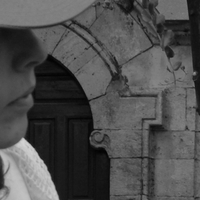



Uploads
Papers by dawid soszyński